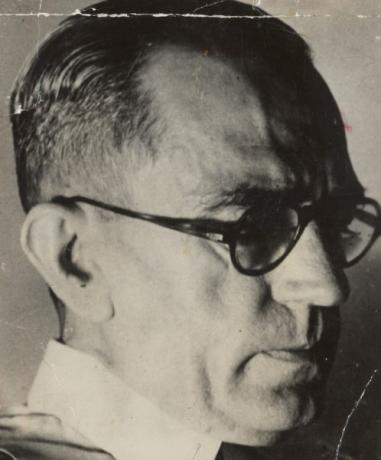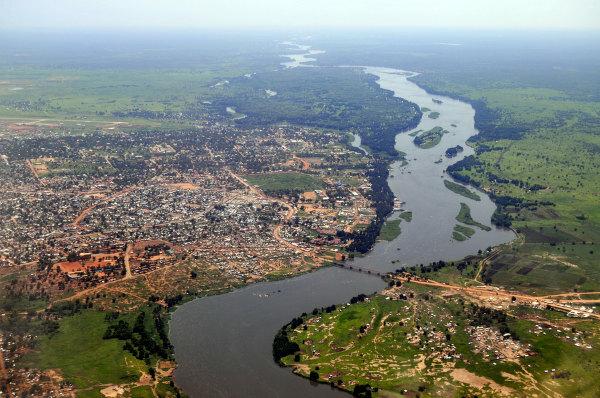Dried lives is a book by Brazilian writer Graciliano Ramos and was first published in 1938. The work, divided into 13 chapters, tells the story of a family of migrants in the northeastern hinterland: Fabiano, Sinha Vitória, the youngest boy, the oldest boy and the dog Baleia.
Thus, the author, who was born in 1892 and died in 1953, builds a narrative without idealizations, as it shows the reality of drought and misery in the Northeast region of the country. For this, it uses an omniscient narrator who narrates through the perspective of the protagonists of this 1930 novel by mBrazilian modernism.
Read too:Anguish - analysis of this other novel by Graciliano Ramos
Topics of this article
- 1 - Summary on Dry Lives
- 2 - Video class on Dry Lives
-
3 - Analysis of the work Vidas secas
- Characters from the work Vidas secas
- Time of work Vidas secas
- Space of the work Dry lives
- Plot of the work Dry lives
- Narrator of the work Vidas secas
- Characteristics of the work Dry lives
- 4 - Graciliano Ramos
- 5 - Historical context of Vidas Secas
Summary about Dried lives
Dried lives it is a romance by the Alagoan writer Graciliano Ramos.
The work was published for the first time in 1938 and tells the story of a family of migrants.
The narrative takes place, possibly, during the beginning of the 20th century, in the northeastern sertão.
The book is narrated by an omniscient narrator who uses the point of view of the protagonists.
Dried lives is part of the second phase of Brazilian modernism.
This work by Graciliano Ramos is characterized by its realistic and regionalist character.
video lesson about Dried lives
Do not stop now... There's more after the publicity ;)
Analysis of the work Dried lives
-
Characters of the work Dried lives
Fabian
Sinha Vitória
the youngest boy
the oldest boy
Whale
the yellow soldier
Tomás da bolandeira
Sinha Terta
Work time Dried lives
The time of the narrative is not specified. But everything indicates that the story takes place sometime during the first three decades of the twentieth century. Thus, in this work, what predominates is psychological time.
work space Dried lives
The northeastern sertão is the space of the book's action Dried lives.
Plot of the work Dried lives
Sinha Vitória, Fabiano, the two children and the dog Baleia, all hungry, crawl in search of shade. In front of them, the “catinga stretched out, an indecisive red speckled with white spots that were bones”. They arrive at an abandoned farm. There, Baleia captures a cavy. Fabiano makes a small fire to roast the game. After the rain, the farm is reborn. The family remains living there, with renewed hopes.
Fabiano does not consider himself a man, because “he was just a goat busy keeping things from others”. And he concludes: “You are an animal, Fabiano.” He notices that the children are “asking”. But he does not see knowledge as something positive: “If I learned anything, I would need to learn more, and I would never he would be pleased.” He remembers Tomás da Bolandeira, who read a lot, and that's why he couldn't stand the hardship. reality.
On one occasion, Fabiano goes “to the town fair to buy groceries”. He takes the opportunity to have a drink and then “went to sit on the sidewalk, resolved to talk”. Then a yellow soldier approaches and invites him to play blackjack. In front of the uniform, he feels intimidated and accepted. Finally, they disagree. Fabiano is arrested, beaten and humiliated by the police.
Sinha Vitória is as brutal as her husband, but smarter than him. She dreams of having “a real bed, made of leather and sucupira, just like Tomás da Bolandeira's”. While Fabiano takes care of the land and the animals, she takes care of the house and the children. The youngest boy admires his father, the way he “put the harness on the sorrel mare and began to tame her”.
O youngest boy wants to be like his father and she decides to ride the goat, “which jumped too much”. But the boy resists until he falls in the sand, humiliated. And he is irritated with his brother and the dog, as he “did not find any sign of solidarity in them”. On the contrary, “the brother laughed like a madman, Baleia, serious, disapproved of all that”.
O older boy is more inquisitive and he wants to know from his mother what hell is. And she also wants to know if she has ever seen hell. Sinha Vitória gets irritated and “applied a cocorote” to him. He is indignant and leaves, accompanied by Baleia, whom he considers “the only living person who showed him sympathy”.
The family decides to go “to the Christmas party in town”. Fabiano is uncomfortable, “tight in his white denim suit made by Sinha Terta”. Sinha Vitória, on the other hand, “was poorly balanced in her shoes with huge heels”. Fabiano gets drunk, looks for a fight, but ends up falling asleep with “the quengo on his cowhide boots”.
Baleia is with her family in the city, the last moment of happiness for the dog, as she soon becomes ill. She grows thin, her hair falls out “in several places” and, on her ribs, “dark spots suppurate and bleed, covered with flies”. Fabiano concludes that she has “a beginning of hydrophobia” and decides to kill the animal.
The family, despite being better off than during the dry season, does not have much money, as Fabiano “received a quarter of the calves and a third of the kids”. In addition, he is always deceived by the boss. When he complains, the boss gets angry, and Fabiano lowers his head.
When he meets the yellow soldier again and has the opportunity to take revenge, because they are alone in the middle of bush, Fabiano lacks the courage: “he took off his leather hat, bowed and showed the soldier the way yellow.”|1| Then, a new drought takes over the region. And the family, again, is forced to migrate.
narrator of the work Dried lives
The romance Dried lives has a omniscient narrator, who has full knowledge of the facts and the inner world of the characters. In this way, the story is narrated from the perspective of these characters.
Characteristics of the work Dried lives
The novel, first published in 1938, has a fragmented look, since it brings the particular vision of each of the protagonists of the work. It is divided into 13 chapters and is part of second phase of mBrazilian modernism. Thus, it has characteristics of the 1930 novel:
social realism;
regionalist character;
absence of idealizations;
narrative partiality;
valorization of space;
determinism;
simple language.
Read too:general field — analysis of this novel by Guimarães Rosa
Graciliano Ramos
Graciliano Ramoswas born on October 27, 1892, in Quebrangulo, in the state of Alagoas. Three years later, he moved to Buíque, in Pernambuco. In 1899, he returned to Alagoas, now residing in the city of Viçosa, where he studied at the Internato Alagoano. In 1905, he went to live in Maceió and study at Colégio 15 de Março.

In 1910, he moved to Palmeira dos Índios, still in Alagoas. In 1927, he became mayor of that city. Due to the political persecution of the Vargas government, he was arrested in 1936, being imprisoned for almost a year. He died March 20, 1953, in Rio de Janeiro.
historical context of Dried lives
The history of Dried lives is possibly located in context of Old Republic (1889–1930). During that period, the latte policy, in which representatives from the states of Minas Gerais and São Paulo took turns in power. At that time, coronelismo also predominated.
Like this, all over Brazil, there were authoritarian farmers (“coroneis”), with financial and political power, who interfered in elections. But this situation began to change when, in 1930, a coup d'état placed Getulio Vargas (1882–1954) in the Brazilian presidency. Later, in 1937, Vargas decreed the new state and established a dictatorship in the country.
Note
|1| RAMOS, Graciliano. Dried lives. 76. ed. Rio de Janeiro: Record, 1998.
By Warley Souza
Literature Teacher
Read the analysis of the book “O fifteen”, learn about the main characteristics of this modernist work and learn a little about the life of its author, Rachel de Queiroz.
Read the analysis of the work “Romanceiro da Inconfidência”, by Cecília Meireles, and learn about the characteristics of this narrative in verses.
Read the review of the book Tent of Miracles. Discover the main features of this work. Also, learn a little about the life of its author, Jorge Amado.
Learn more about Angústia, the third book by Graciliano Ramos. Understand the historical context of the work, read a summary of the narrative and its literary analysis.
Read the review of the book Captains of the Sand. Know its plot, structure, characters and social critique. Also learn a little about the author's life.
Meet the modernist writer Erico Verissimo. Find out what are the main characteristics of his works. Also, read some quotes by this author.
Read the biography of Graciliano Ramos. Understand the literary characteristics of your works. See excerpts and famous quotes from the author about life and literature.
Click here, find out who the Brazilian writer Jorge Amado was and learn about the main characteristics of his works.
Meet the modernist writer José Lins do Rego. Find out what are the characteristics of his main works. See a summary of his book "Dead Fire".
Learn more about Modernism in Brazil, its historical context, its European influences and proposed ruptures. Check out its stages, main works and artists.


